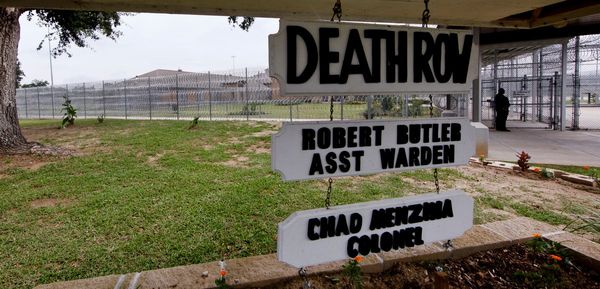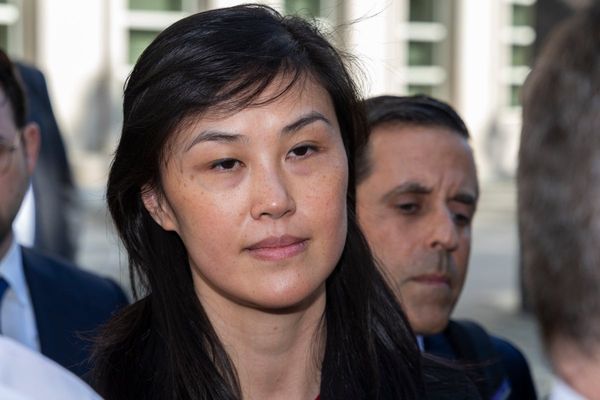
She was a painter, he was a sculptor. They worked side by side, describing their marriage as “a 64-year conversation about art”. They influenced one another’s work and regarded one another as equals – but today, Anthony Caro is a household name while Sheila Girling is all but forgotten.
This weekend, however, the couple’s son, Paul Caro, and grandson, Ben Caro, hope that’s about to change. They’ve been instrumental in helping to organise a comprehensive exhibition of her work: more than 90 paintings and collages go on display at the Bowhouse community space in St Monans, near St Andrews, Scotland (to 1 September, with a break in August – see spacetobreatheexpo.com for details).
The works, suspended from the rafters and ranged around the walls, are a mixture of large-scale abstract pieces, collages and – from Girling’s later life – more figurative paintings, and smaller works. “She was a wonderful artist,” says Sophie Camu, the exhibition’s curator. “Her use of both colour and space in her works is extraordinary – she had an ability to express emotion and suggest form through a layering and juxtaposition of colour. The work looks absolutely stunning in situ, and I think people are going to be blown away by what they see here.”
Paul Caro says his mother, who would have been 100 this month, would have been delighted with the show – as would his father. “My parents were totally equal,” he says. “They didn’t regard his work as more important than hers. They worked in the same building, and they would wander in and out of one another’s studios and look at one another’s work and suggest things.”
A piece in point is Early One Morning (1962), one of Anthony Caro’s best-known pieces, described by the Tate, where it’s part of the permanent collection, as “a major example of the kind of sculpture that established him as the leading young sculptor of the 1960s”. Its bright red colour is an important part of its success – but, remarks Paul Caro, the piece was originally green. “My mother went to look at it and said: ‘You can’t have it that colour. It has to be red.”’ Another important Anthony Caro work, Month of May, is well known for its vibrant three colours – and again, says Paul, his mother was pivotal in helping to decide the all-important shades.
Caro and Girling met as art students at the Royal Academy and married in 1949; but after the births of their two sons in the 1950s, art took a back seat for Girling, while Caro’s work and reputation flourished. The family lived for a time in the US, and it was during their stay there that Caro, but also Girling, got to know many pivotal figures of the time, including the art theorist Clement Greenberg and artists including Jules Olitski, Robert Motherwell and Helen Frankenthaler. The impact of these connections on Caro’s work has been much discussed – but they also had a huge impact on Girling. When the family returned to London in the late 60s, she returned to her canvases, now using the acrylic paints that had been suggested to her by Kenneth Noland, another artist in their circle in the US – he was a leading figure in the American “color field” movement.
In the 1980s, Girling began to incorporate cut, torn and pasted canvas or paper into her work – a fusion that allowed her further experimentation. Her work Beyond a Dream (1992) – a burst of ethereal cloud-like spaces ranged alongside bright flashes of magentas, golds and blues – brings, says Camu, all Girling’s skills together. “What you see is real depth – it seems to vibrate with energy, and shows what a fabulous artist she was,” says Camu.
Ben Caro, director of the Anthony Caro Centre and the Sheila Girling Studio, was close to his grandparents growing up and says he would dive into a heap of cut canvas with his grandmother, and have a go at welding with his grandfather. Of Girling he says: “Her work has been overlooked, although it was highly respected during her lifetime. But with a partner that famous, in a male-centric art world, she was overshadowed. I feel I have to try to change Sheila’s legacy: I’ve felt angry in the past about the lack of knowledge about her work, and I feel overwhelmed that this show is coming along to hopefully change things.”
For this year’s Frieze art fair in London in October, he says, the plan is to have a large display of Girling’s work on show.
At the Bowhouse exhibition many of the exhibits are on sale, with prices from £3,000 to £30,000 – but, says Camu, the idea is to keep a record of where works have gone so they can be requested for future shows. It would be wonderful, says Camu, to have more work by Girling in public galleries – she, along with the Caro family, hopes this year will be a turning-point in Girling’s posthumous legacy. Perhaps like Frida Kahlo – whose husband Diego Rivera always overshadowed her during their lifetimes, but who now has been almost totally eclipsed by his wife – the best for Sheila is yet to come.







